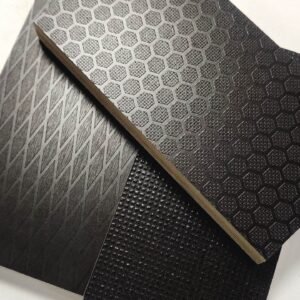Description
Anti-slip Wire Mesh Film Faced Plywood
Anti-slip Wire Mesh Film Faced Plywood applied to one or both sides is known as wire mesh plywood or anti-slip film facing plywood. The film is often made of a paper or plastic material that has been impregnated with resin and adhered to the plywood’s surface. The anti-slip coating roughens the surface, improving grip and reducing the risk of falling. This makes the flooring configuration particularly suitable for various application areas.
In order for the concrete structure and components to be formed according to the specified position and geometric size, maintain their correct position, and bear the weight of the building template and the external load acting on it, the film faced plywood is a type of temporary supporting structure that is made in accordance with the design requirements.
Different types of wood, including poplar, eucalyptus, and pine, can be used to make the fundamental core board of Anti-slip Wire Mesh Film Faced Plywood.
Large size, light weight, reusability, good heat preservation, corrosion resistance, and good building function are all benefits of film faced plywood.
Anti-slip Wire Mesh Film Faced Plywood is smooth and slip-resistant surfaces can survive a variety of weather and chemical conditions, and the panels’ multi-layer construction gives them remarkable strength and makes them ideal for the creation of wear-resistant surfaces.
Plywood that is anti-slip (F/W) is used for the flooring of trailers, vans, and rail cars. Our particular non-slip product is used for flooring when building warehouses, loading platforms, scaffolds, and playgrounds in addition to the transportation industry. Slip-resistant plywood has been used in shipbuilding for ship decks.
Since veneer is covered with film, only laminating flaws are taken into account while grading. Additionally, exterior-visible wood flaws are taken into consideration. Different hues and coating densities are offered for water-resistant coating. The panel’s edges are water-resistant taped.

Anti-slip Wire Mesh Film Faced Plywood Features
- Being light, It is more suited for bridge construction and high-rise structures.
- It may be reused numerous times if utilized and stocked properly, which can significantly save costs.
- It keeps the surface smooth and attractive when used for pouring, and since it can be used to decorate right away, you won’t need to repaint the wall. This will shorten the building time by 30%.
- Iron formwork has the drawbacks of being rusty and erosive, but it won’t dirty the surface of the concrete.
- The fact that it may be used as a template for curved surfaces makes it useful for construction in the winter.
- It is easier to drill, saw, and nail than bamboo plywood and small steel plywood. It can be transformed into a template with any shape needed.
Application
- Sites of construction and scaffolding
- Walkways and decks in commercial and maritime settings
- outdoor steps, a play area
- Docks for loading and warehouse floors
- trucks and trailers loading ground
- floors of vehicles and vans
- Commercial and industrial flooring
Environmental
Anti-slip Wire Mesh Film Faced Plywood has Lower carbon footprint: The manufacturing of plywood uses less energy than the fabrication of steel or concrete, which both need large quantities of energy. As a result, Anti-slip Wire Mesh Film Faced Plywood has a less carbon footprint.
Anti-slip Wire Mesh Film Faced Plywood is a recyclable and biodegradable substance, making it possible to reuse it or dispose of it without endangering the environment. Contrarily, commodities like steel or concrete can wind up in landfills where they could harm the environment.
Reduced waste: Because plywood comes in conventional sizes and can be easily cut to meet precise measurements, less waste is produced when building. Steel or concrete may require more cutting, which increases waste.
Insulation qualities: Plywood naturally insulates, which can help buildings use less energy for heating and cooling. When compared to materials like concrete or steel, which lack natural insulating characteristics, this can result in cheaper energy expenditures and a smaller carbon impact.
Emissions from transportation are decreased since plywood is lightweight and portable, which lowers these emissions. This is crucial for substantial building projects that call for the transportation of vast amounts of materials.









